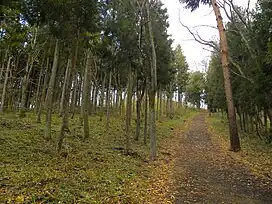| Mount Kinkei | |
|---|---|
| 金鶏山 | |
 Mount Kinkei | |
| Highest point | |
| Elevation | 98.3 m (323 ft) |
| Coordinates | 38°59′36.4″N 141°06′33.2″E / 38.993444°N 141.109222°E |
| Geography | |
 Mount Kinkei  Mount Kinkei Mount Kinkei (Japan) | |
| Type | Cultural |
| Criteria | ii, iv |
| Designated | 2011 |
| Reference no. | 1277 |
Mount Kinkei (金鶏山, Kinkei-san or Kinkei-zan) is a conical hill in the town of Hiraizumi in southwestern Iwate Prefecture, Japan. The mountain is part of the UNESCO World Heritage Site Historic Monuments and Sites of Hiraizumi.
Overview
Mount Kinkei is a sacred mountain that has influenced the spatial layout of the temple complex at Hiraizumi. It lies approximately halfway between the temples of Chuson-ji and Mōtsū-ji. According to the legend, the hill was built in a single night by Fujiwara no Hidehira of the Northern Fujiwara to the west of Muryōkō-in temple, which was intended to be a copy of the Byōdō-in temple in Uji (near Kyoto). The name of the hill is said to be derived from a golden cockerel was buried on the top.
In 1930, illegal excavations to find the legendary golden cockerel uncovered ceramic and earthenware and copper sutra containers, indicating that the summit of the hill was used as a sutra mound. The sutra containers are now at the Tokyo National Museum.
Subsequent excavations found the remains of a Hall identified as belonging to Zaō Gongen; associated with the cult of Miroku.[1][2][3]
On 22 February 2005, Mount Kinkei was declared a national historic site.[4]
Gallery
 Senju-do chapel and entrance to hiking path
Senju-do chapel and entrance to hiking path Senju-do chapel
Senju-do chapel Entrance to climbing path
Entrance to climbing path Inside Senju-do chapel
Inside Senju-do chapel Yoshitsune's wife &child gravestones
Yoshitsune's wife &child gravestones
See also
References
- ↑ 金鶏山 [Kinkeizan] (in Japanese). Agency for Cultural Affairs. Archived from the original on 20 July 2012. Retrieved 3 August 2012.
- ↑ "Mt. Kinkei". Hiraizumi Tourism Association. Archived from the original on 14 July 2012. Retrieved 16 May 2011.
- ↑ Yiengpruksawan, Mimi Hall (1998). Hiraizumi: Buddhist Art and Regional Politics in Twelfth-Century Japan. Harvard University Press. p. 110. ISBN 0-674-39205-1.
- ↑ Agency for Cultural Affairs - Cultural Heritage Online (in Japanese)